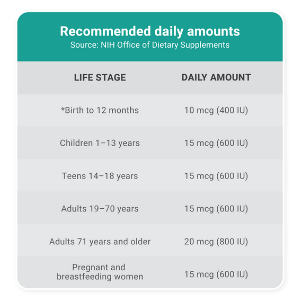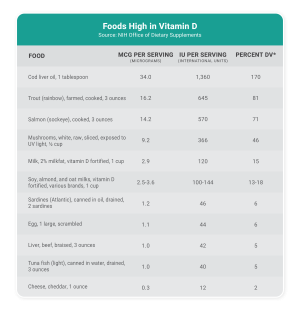Vitamin D has had its day in the sun multiple times in the past 100 years. From being identified as the cause of rickets when a deficiency occurs in adolescence to more recently being hailed as a critical component of a healthy immune system – vitamin D has certainly made a name for itself.
But what is this vitamin – and how does it help us? Read on to learn more about vitamin D, how it works, and why we need it.
What is Vitamin D?
Vitamin D (sometimes referred to as calciferol) is a fat-soluble hormone, and is often referred to as the “sunshine vitamin”. Found naturally in some foods and sunlight, it helps us stay healthy and maintain bone health. Vitamin D can be absorbed naturally by the body and it’s the only one of the 13 vitamins that can be made by the human body.
Cells in our bodies have Vitamin D Receptors (VDR’s) which allow this crucial vitamin to bind and modulate absorption of calcium. Because of this feature, the FDA states that, “Adequate calcium and vitamin D, as part of a well-balanced diet, along with physical activity, may reduce the risk of osteoporosis.”
There are two types of vitamin D: Vitamin D2 (also known as ergocalciferol), which can be found in some plant sources, and vitamin D3 (or cholecalciferol), which can be found in animal-sourced foods and is made by your skin when exposed to sunlight. Learn more about the differences between vitamin D2 and D3 on our blog.

How much vitamin D do I need?
These are the NIH-recommended daily amounts of vitamin D you need depending on your age. These are adequate for 97-98% of people. Because it’s difficult to get vitamin D from diet and sunlight alone, some individuals may find it beneficial to take supplements.
*Note: this is considered an “adequate intake”. There isn’t sufficient evidence to provide a “recommended daily allowance” for infants.

How can I get vitamin D from the sun?
Another way to get more vitamin D is through sunlight. It’s estimated that nearly 90 percent of vitamin D intake comes from the sun. Several factors affecting how your body absorbs sunlight, including the season, your skin type, how much skin is exposed, time spent in the sun, pollution, and where you’re located on earth. However, researchers recommend an average of 12-15 minutes per day with 40 percent of your skin exposed in order to get the maximum benefit from sunlight.
How do I know I’m getting enough vitamin D?
The best way to measure vitamin D is by observing 25-hydroxyvitamin D levels in your blood, which can be observed through a simple blood test. With this test, you can even get checked right from your home.
![]()
![]()
![]()
What happens if I have a vitamin D deficiency?
Without enough vitamin D, you may develop thin, brittle bones that are weak and soft. In children this condition causes the bones to bend and it’s called rickets. In adults, having soft bones is a condition called osteomalacia, which causes bone pain and muscle weakness.
Other symptoms of deficiency could include mood changes (like depression), bone loss, muscle and joint pain, and fatigue. Because these symptoms are fairly common, it’s difficult to diagnose vitamin D deficiency without getting tested.
Groups at risk for vitamin D deficiency include breastfed infants, older adults, people with dark skin, and people with disorders like Crohn’s disease or celiac disease which prevent them from properly absorbing the nutrient.
Want to learn more about your vitamin D status? There’s an easy way to find out – simply order one of our at-home vitamin D tests, and get results in just 48 hours.


